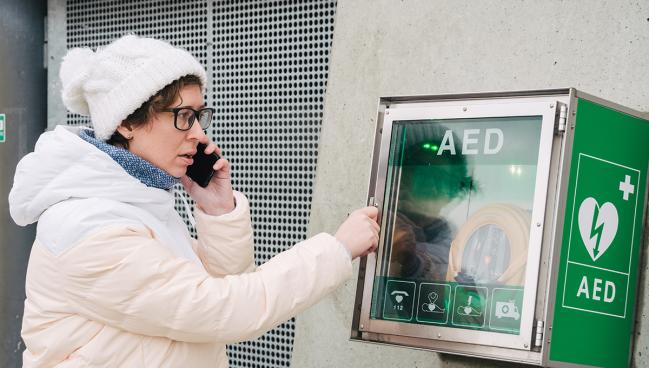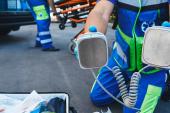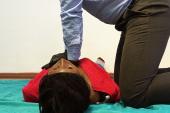‘I Have the Cure’: App Volunteers Up Bystander CPR and AED Use in OHCA
A cadre of responders, alerted by a text or notification, is a commonsense approach that might save lives, a new study hints.

The activation of a system to dispatch volunteer responders—done with a smartphone application or text message—is associated with a greater chance that people experiencing out-of-hospital cardiac arrest (OHCA) will receive bystander CPR and defibrillation, and that they’ll survive their event, according to a new analysis.
Researchers say these results, in light of the historically low rates of bystander CPR and underuse of automated external defibrillators (AEDs), provide support for activating trained volunteers to respond to OHCA.
“Survival in cases of OHCA can dramatically be increased if cardiopulmonary resuscitation is promptly initiated and an AED is used within minutes,” Martin Jonsson, PhD (Karolinska Institutet, Stockholm, Sweden), and colleagues write in their paper published online July 10, 2023, in the Journal of the American College of Cardiology. “Unfortunately, emergency medical services usually arrive too late, and survival rates are low.”
As an advocate for volunteer-response teams for more than two decades, Douglas Zipes, MD (Indiana University School of Medicine, Indianapolis), who wasn’t involved in the study, said available data suggest there are 350,000 sudden cardiac arrests in the US each year, roughly the equivalent of three or four Boeing 747 airplanes crashing every day. The majority of these events are fatal.
It’s been a huge problem for 50 years, and the frustrating thing for me as a cardiac electrophysiologist is that I have the cure: the cure is a shock to the chest. Douglas Zipes
“It’s a huge problem,” Zipes told TCTMD. “It’s been a huge problem for 50 years, and the frustrating thing for me as a cardiac electrophysiologist is that I have the cure: the cure is a shock to the chest. The problem is getting it there within a reasonable time frame. It’s so simple and yet so difficult, and that’s what make it very frustrating.”
While not every cardiac arrest can be saved by the AED, “a good percentage can be if we get the shock there as quickly as possible,” he said. Given the importance of time, Zipes said increasing CPR education and making AEDs more widely available aren’t enough to reduce the burden of sudden cardiac arrests. “What we basically need is a cadre of responding individuals and to have the AED to resuscitate these individuals when they go down,” he said.
Growing Evidence Supporting Use of Volunteers
The new study is a retrospective, observational analysis of five European sites—two in Sweden, two in Denmark, and one in the Netherlands—participating in the ESCAPE-NET collaborative research network.
As part of the programs, which were started between 2009 and 2017, registered volunteers with prior CPR training agreed to be located and dispatched to people having a cardiac arrest. Volunteers were located by a smartphone app that tracked their whereabouts within their respective region, and when alerted by the app or text message, they were dispatched to either collect the AED or go directly to the cardiac arrest to begin CPR. The alert systems were integrated with information about publicly available AEDs, including their location and times of accessibility. All systems were triggered by dispatchers in response to an emergency call.
In total, 9,553 OHCAs were included in the analysis, with the volunteer-response system activated in 4,696 cases. When sites were combined, patients in the activated-response arm had similar ages and EMS response times as those cases where the system wasn’t activated. When the volunteer system was activated, the people experiencing OHCA were more likely to be women, to have a cardiac arrest at home, and to have ventricular fibrillation as the first recorded rhythm.
The proportion of OHCA cases where bystander CPR was initiated was 73.8% with the volunteer-response system versus 61.9% in the usual-care group. Bystander defibrillation was also higher when the response system was started (7.9% vs 4.6% with usual care). This appeared to translate into improved survival: the 30-day survival was 12.9% when the volunteer system was activated versus 10.0% with usual care. Rates of bystander CPR and AED use, as well as 30-day mortality, with the volunteer-response team was best in the Netherlands, where the program is in place in the North Holland North region.
After inverse-probability treatment weighting using a propensity score to account for baseline imbalances, activation of the volunteer response system was associated with a greater likelihood of bystander CPR (RR 1.30; 95% CI 1.15-1.47), bystander AED use (RR 1.89; 95% CI 1.36-2.63), and 30-day survival (RR 1.22; 95% CI 1.07-1.39).
“The findings in our study add to the growing evidence of positive reports on outcome from volunteer responder systems, and they support current guideline recommendations,” write Jonsson and colleagues. “However, to show causal effects on such a rare event as survival in OHCA, randomized trials are needed.”
As a scientist, Zipes agrees about the need for a prospective randomized, controlled trial to assess effects on mortality, but he said the “humanist” in him wants to see volunteer-response programs in place now. “Common sense tells me that a certain percentage of sudden deaths have a rhythm problem that can be reversed,” said Zipes. “Let’s just do it.”
Putting Out Fires
In an editorial, Janet Bray, RN, PhD (Monash University, Melbourne, Australia), Christopher Smith, MBChB, PhD (University of Warwick, Coventry, England), and Ziad Nehme, PhD (Monash University), highlight some of the limitations of the current analysis. For example, they point out that the comparator groups in the five sites were patients with OHCA for whom the alert system wasn’t activated. That comparison is problematic, they write, because the emergency dispatcher needs to recognize that an OHCA has occurred.
“Including patients in whom the dispatcher did not recognize the OHCA (approximately 25% of cases) introduces significant bias,” they state. “These patients receive a different emergency medical service response, no opportunity for telephone CPR instructions and AED retrieval, and have worse outcomes.”
These first-responder systems also have patient selection criteria for alerts, which can also introduce imbalances between the two groups. Moreover, not every person who receives the alert may accept it or respond, add the editorialists, noting the present study does not include information on response rates. In addition to the need for randomized trials to assess OHCA survival with such volunteer programs, Bray and colleagues believe there is a need to optimize the intervention further. Automating the alerting process based on prespecified criteria may reduce dispatcher bias and speed up activation, they suggest.
One of the challenges with OHCA is that it’s difficult to identify most people before the event occurs, said Zipes. As a result, it’s critical to be responsive when it does happen. A “neighborhood heart watch program” could be mobilized with current technology to get trained responders to those having a sudden cardiac arrest, as well as direct them to the nearest AED.
“For a layperson to face a dying individual and to be able to do CPR, and then attach and deploy a defibrillator, is very stressful,” said Zipes. “I think we need a special cadre of people to do this if we’re going to face the problem. A volunteer fire department is trained to very effectively respond to a fire. We need a trained group of volunteers much like that who are going to be volunteer cardiac-arrest responders. I think they’ll do a better job than expecting a senior in high school who took health class 6 months ago to respond to cardiac arrest.”
Zipes, who lives just outside Indianapolis, placed an AED in a mailbox-like container on his front lawn roughly 20 years ago and gave the community lessons in CPR and how to use the defibrillator, in addition to keys to the container. So far, the device has not been used. “It’s that kind of concept to have an AED at your fingertips,” he said. “That’s how we’re going to take care of this.”
Michael O’Riordan is the Managing Editor for TCTMD. He completed his undergraduate degrees at Queen’s University in Kingston, ON, and…
Read Full BioSources
Jonsson M, Berglund E, Baldo E, et al. Dispatch of volunteer responders to out-of-hospital cardiac arrests. J Am Coll Cardiol. 2023;82:200-210.
Bray JE, Smith SM, Nehme Z. Community volunteer responder programs in cardiac arrest: the horse has bolted, it’s time to optimize. J Am Coll Cardiol. 2023;82:211-213.
Disclosures
- Jonsson reports no conflicts of interest.
- Bray and Nehme are funded by National Heart Foundation of Australia Fellowships. Nehme has received funding from the National Heart Foundation of Australia to support a clinical trial using the GoodSAM application





Comments